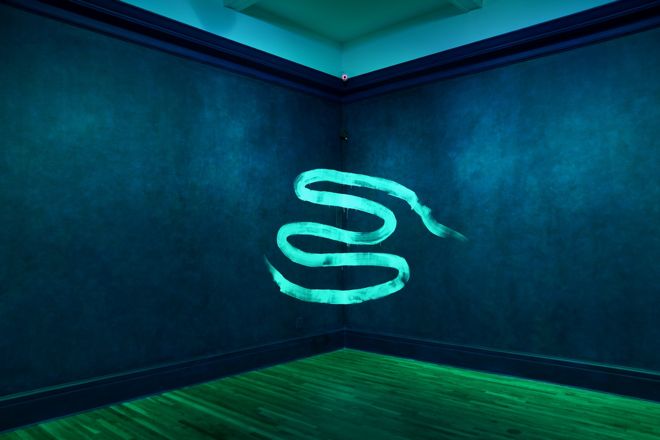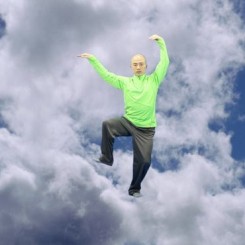The Armory Show may be smaller in scale this year (209 galleries compared with 228 last year) but it was no less vital. Not content with putting on a run-of-the-mill fair, it inundated viewers with exhibitions, lectures and special features, and partnered with the online art platform Artsy to provide a comprehensive guide to the fair. It was difficult, at times, to keep track of everything on offer; particularly chaotic was the China Focus section which, despite the amount of hoopla that surrounded it in the run up to the fair, was squeezed into a small back section. A special project from the Polit-Sheer-Form-Office collective dominated the section, with their bright blue exercise equipment installed throughout the large public lounge. “Fitness For All!,” certainly injected some fun into the event, and it was definitely a favorite of fair goers judging from the wide smiles as they swung their limbs and twisted their hips, but it encroached too closely on some booths (Zhang Ding’s conceptual installation got lost in the shuffle) and competed fiercely for viewer’s attention with MadeIn Company’s performance piece “Physique of Consciousness,” (2013), in which objects are thrown into the air from inside a white cube. Flashy booths (Double Fly at Beijing’s Space Station) overwhelmed quieter presentations such as that of Pekin Fine Arts. China Focus was certainly a hoping party. Frantic and confusing at the same time, it rather lived up to the reputation of its namesake country. The commissioned artist this year was Xu Zhen, but outside the boundaries of China Focus, his presence was barely felt aside from a couple of reimagined CitiBikes with decals of his work “Under Heaven” (2013) scattered throughout the entrance area, and his soft sculpture limited edition piece for the fair “Currency’s Ideal” (2014), which graced the VIP lounge.
Still, the selection of Chinese artists and representing galleries in this section presented an admirable effort. There was nary a smiley pink face (save for Yue Minjun’s appearance at Galerie Daniel Templon), as the China Focus placed emphasis on emerging artists and experimental practices. Zhang Ding played with monuments and icons in ShanghART/ Galerie Kringzinger’s booth with an installation that consisted of paintings and sculpture. Beijing’s Aye Gallery showed Ji Dachun’s satirical paintings—a selection of beautifully precise acrylic works that reference the macabre (a headless stork in “Mindlessness,” 2011) and the absurd (“Richter’s Toilet Paper,” 2005). Elsewhere in the fair, galleries were equally thoughtful in their choices of Chinese artists. Sean Kelly presented new colorful ink drawings from Sun Xun that the artist made during his residency at the gallery last fall. Galerie Thaddaeus Ropac included a painting by Yan Pei-ming alongside such heavyweights as David Salle and Alex Katz. Galeria Nara Roesler did not show Chinese artists, but did include a piece from British artist Isaac Julien from his “Ten Thousand Waves” video projects shot in Shanghai and Southern China.

Venus drawn out: 20th Century Works by Great Women Artists. Pat Steir (b. 1940). Floating Line, 2014
致敬维纳斯:20世纪伟大女性艺术家作品展。帕特•斯特尔(1940年生),《浮线》,2014年
There was certainly no shortage of conversation starters to keep viewers engaged and surprised. Blain Southern brought crowd—and Snickers—to their booth with English artists’ Tim Noble & Sue Webster’s “The Wedding Cake,” a bisected bust of Mussolini filled to the brim with jutting penises. The piece is based on Renato Bertilli’s “Head of Mussolini (Continuous Profile).” Postmasters Gallery went for shock value with the inclusion of Brooklyn-based artist Monica Cook; “Reno with Hoagie, Tenderfoot, Precious, and Baby Corn” (2014) which depicts a seated pig, fur matted, torso open, exposing a piglet suckling at her innards. Two other piglets scamper around the stool, seemingly vying for attention. Its grotesque beauty both mesmerized and repulsed viewers in equal amounts. A co-presentation from Berlin’s Thomas Schulte and Santa Monica’s Christopher Grimes impressed with beauty on a grand scale. Inigo Manglano-Ovalle’s mercurial “Storm Prototype II” hung from the ceiling, its shape reminiscent of swirling hurricane winds or atomic mushroom clouds. The aforementioned Double Fly Art Center, presented by Space Station, had perhaps one of the most engaging works. Those familiar with the sheer insanity of their music videos (included in the booth) will not be surprised by the gleeful absurdity of their carnival games, in which viewers vie for prizes like paper shoes and McDonald’s containers. The booth was a riotous explosion of color and chaos with plastic wrapped prizes festooning the walls along with “Balloons,” a large portrait of the artists in their skivvies.
In general, however, the fair was an exercise in restraint and good taste. James Cohan Gallery featured the work of Michelle Grabner, who is having a stellar year so far as one of the co-curators of the Whitney Biennial, the opening of which coincided with the Armory Show for the first time. Known for her textured paintings of traditional domestic fabrics, Grabner displayed some spare monochrome versions this time. Francois Ghebaly Gallery dedicated their booth to another Biennial artist, the late Channa Horwitz, who’s having a posthumous revival. She had a memorable showing at the Venice Biennale last year, and Hauser & Wirth will include her in a group show opening at the end of the month. It’s not surprising, then, that the gallery nearly sold out of her work during the first hour of the preview day. Her geometric graph drawings, derived from musical compositions and math theories, take their inspiration from both logic and abstraction. Biennial artists played a major part in Susanne Vielmetter Los Angeles Projects as well, including two female artists—Shana Lutker and Amy Sillman.

Abelardo Morell, “Camera Obscura: View of Central Park Looking North,” 2009 (Edwynn Houk Gallery)
阿贝拉多•莫瑞尔,《针孔相机:中央公园向北风景》,2009年(埃德温•胡克画廊)
In fact, female artists had some of the strongest showings at the fair, no doubt to coincide with “Venus Drawn Out,” a specially curated show in the Modern section that features the work of female artists taken from a selection of participating galleries. A charcoal drawing from Kara Walker covered an entire wall of the booth of Sikkema Jenkins & Co., while neon text pieces from Tracy Emin greeted viewers as they walked into Lehman Maupin’s space; the gallery also included a piece from Mickalene Thomas, “Hair Portrait #18” (2013), that sparkled with the addition of black rhinestones. Germany’s Spruth Magers had a virtual bonanza of women, starting with a wall dedicated to Jenny Holzer’s “Living Series” (1980 – 1982). Inside, there were works from Thea Djordjadze, Astrid Klein and Louise Lawler, who photograph artworks in museums, storage facilities, auctions and private collections, offering a different perspective of how we view art. Amy Sillman made another appearance at Crown Point Press the American answer to the Singapore Tyler Print Institute, where Sophia Coppola was spotted taking pictures in the booth. Brooklyn-based Spanish artist Elena del Rivero occupied the booth of Galeria Elvira Gonzalez with her series “Flying Letters”—hand-made paper works stitched with feathers. Her works are subdued, thoughtful and skillfully executed, as are most of the works on offer throughout the fair.



